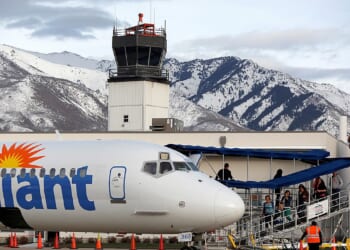President Donald Trump recently suggested that “bad fuel” had caused the crashes of a US Navy fighter jet and helicopter in the South China Sea. An investigation is ongoing.
When a US Navy MH-60R Seahawk helicopter and an F/A-18 Super Hornet crashed in the South China Sea within 30 minutes of each other, speculations instantly began to mount. The Navy initially revealed that the helicopter and the fighter jet—both of which had been stationed aboard the USS Nimitz aircraft carrier—both crashed into the sea while conducting routine operations. Fortunately, all crew members aboard both craft were safely recovered.
However, this cluster of mishaps rightfully was concerning. Earlier this week, President Donald Trump suggested that contaminated fuel may have played a role in both incidents.
“They’re gonna let me know pretty soon,” Trump told reporters while flying aboard Air Force One on Monday. “I think they should be able to find out. It could be bad fuel. I mean, it’s possible it’s bad fuel. Very unusual that that would happen.” The president added that he did not believe foul play was involved in the crashes.
The Sikorsky SH-60 Seahawk has remained a key player in the Navy’s aerial strategy since the 1980’s. Around this time, the service was seeking a replacement for its Karman SH-2 Seasprite platform. The resulting Seahawk helicopter is considered to be one of the most dominant aircrafts in its class today.
Nicknamed the “Romeo,” the helicopter features a host of advanced capabilities, including top-notch digital sensors, a fully-integrated mission system, lethal armament power and an unmatched sustainment program. According to its Lockheed Martin manufacturer, the Seahawk’s Performance Based Logistics program for the platform enables 95% flight readiness and availability, a statistic that no other maritime helicopter comes close to. The twin-engine helicopter can be used for search and rescue missions, anti-submarine warfare, drug interdiction and other special operations.
Serving as the backbone of the Navy’s carrier air wing, the F/18 Super Hornet has earned an impressive reputation over its decades in the air. The advanced frontline carrier-based strike fighter. From armament power to sensors, the tried and trusted fighter is a fan favorite among aviation buffs and military experts alike.
The jet is equipped with the APG-79 active electronically scanned array AESA radar and newer Block III models feature the Distributed Targeting Processor-Networked mission computer and Tactical Targeting Network Technology link system. In terms of weaponry, it is designed with eleven hardpoints distributed at the wingtips, under the fuselage, and under the wing. The fighter can carry a range of short-range Sidewinder missiles, Joint Standoff Weapons, AMRAAMs, Small Diameter Bombs, the Harpoon, the Maverick, and other missiles.
Considering these capabilities, the loss of the Seahawk and Super Hornet earlier this month is a real blow to the Navy. Notably, the USS Nimitz is currently on its final leg of its final deployment, as the 50 year-old aircraft carrier is expected to decommission next year.
About the Author: Maya Carlin
Maya Carlin, National Security Writer with The National Interest, is an analyst with the Center for Security Policy and a former Anna Sobol Levy Fellow at IDC Herzliya in Israel. She has by-lines in many publications, including The National Interest, Jerusalem Post, and Times of Israel. You can follow her on Twitter: @MayaCarlin. Carlin has over 1,000 articles published over the last several years on various defense issues.
Image: Shutterstock / zef art.


















